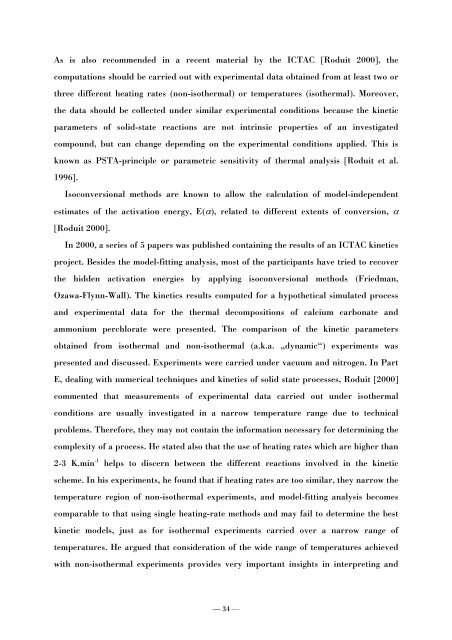PDF - Institut national polytechnique de Toulouse
PDF - Institut national polytechnique de Toulouse
PDF - Institut national polytechnique de Toulouse
Create successful ePaper yourself
Turn your PDF publications into a flip-book with our unique Google optimized e-Paper software.
As is also recommen<strong>de</strong>d in a recent material by the ICTAC [Roduit 2000], the<br />
computations should be carried out with experimental data obtained from at least two or<br />
three different heating rates (non-isothermal) or temperatures (isothermal). Moreover,<br />
the data should be collected un<strong>de</strong>r similar experimental conditions because the kinetic<br />
parameters of solid-state reactions are not intrinsic properties of an investigated<br />
compound, but can change <strong>de</strong>pending on the experimental conditions applied. This is<br />
known as PSTA-principle or parametric sensitivity of thermal analysis [Roduit et al.<br />
1996].<br />
Isoconversional methods are known to allow the calculation of mo<strong>de</strong>l-in<strong>de</strong>pen<strong>de</strong>nt<br />
estimates of the activation energy, E(α), related to different extents of conversion, α<br />
[Roduit 2000].<br />
In 2000, a series of 5 papers was published containing the results of an ICTAC kinetics<br />
project. Besi<strong>de</strong>s the mo<strong>de</strong>l-fitting analysis, most of the participants have tried to recover<br />
the hid<strong>de</strong>n activation energies by applying isoconversional methods (Friedman,<br />
Ozawa-Flynn-Wall). The kinetics results computed for a hypothetical simulated process<br />
and experimental data for the thermal <strong>de</strong>compositions of calcium carbonate and<br />
ammonium perchlorate were presented. The comparison of the kinetic parameters<br />
obtained from isothermal and non-isothermal (a.k.a. „dynamic“) experiments was<br />
presented and discussed. Experiments were carried un<strong>de</strong>r vacuum and nitrogen. In Part<br />
E, <strong>de</strong>aling with numerical techniques and kinetics of solid state processes, Roduit [2000]<br />
commented that measurements of experimental data carried out un<strong>de</strong>r isothermal<br />
conditions are usually investigated in a narrow temperature range due to technical<br />
problems. Therefore, they may not contain the information necessary for <strong>de</strong>termining the<br />
complexity of a process. He stated also that the use of heating rates which are higher than<br />
2-3 K.min -1 helps to discern between the different reactions involved in the kinetic<br />
scheme. In his experiments, he found that if heating rates are too similar, they narrow the<br />
temperature region of non-isothermal experiments, and mo<strong>de</strong>l-fitting analysis becomes<br />
comparable to that using single heating-rate methods and may fail to <strong>de</strong>termine the best<br />
kinetic mo<strong>de</strong>ls, just as for isothermal experiments carried over a narrow range of<br />
temperatures. He argued that consi<strong>de</strong>ration of the wi<strong>de</strong> range of temperatures achieved<br />
with non-isothermal experiments provi<strong>de</strong>s very important insights in interpreting and<br />
— 34 —
















